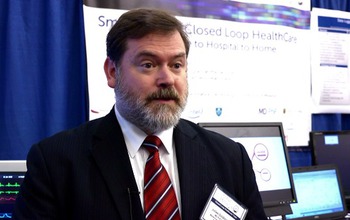![]()
Doctor develops open-source software to link healthcare systems at home and in hospitals

Closed Loop Healthcare team aims to make medical technologies interoperable.
The following is part 6 of the Smart America series showcasing National Science Foundation (NSF) researchers designing improved cyber-physical systems. In parts 1 through 5, learn about cyber-dogs, tele-robotics, smart shape technology research, drones for disaster relief and in-home fall detection systems.
Julian Goldman, a physician at Massachusetts General Hospital, knows better than most the frustrations that doctors face when they're confronted with computer systems and devices that just won't communicate with each other.
The research team at his lab has been a pioneer in developing open-source software and standards designed to integrate the various technologies used in homes and hospitals. Goldman's lab created a computing platform called Open ICE (integrated clinical environment) to begin to address these problems.
The effort, in turn, led to the development of a community of like-minded researchers and manufacturers that would like to break barriers in health care through better information exchange, better communication among and between medical devices and electronic health records, and, ultimately, through smart apps designed to improve patient safety and decrease the cost of health care.
"Our involvement with Smart America has been an exciting, six-month wild ride," said Goldman, who co-chaired the Closed Loop Healthcare team with Marge Skubic, director of the Center for Eldercare and Rehabilitation Technology at the University of Missouri.
"We've all learned a lot from each other," he said. "Our contact and our work together has influenced our perception of our work, including how to make our own work more accessible to collaborators. That is extremely valuable and typically very hard to do."
The Smart America Expo brought together leaders from academia, industry and government to demonstrate the ways that smarter cyber-physical systems--sometimes called the "Internet of Things"--can lead to improvements in health care, transportation, energy and emergency response, and other critical areas.
--
Aaron Dubrow, NSF (703) 292-4489 adubrow@nsf.gov
Nenhum comentário:
Postar um comentário
Observação: somente um membro deste blog pode postar um comentário.